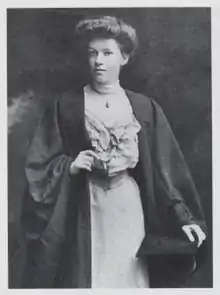Olive Purser
Olive Purser (1886–1973), was one of the first women to enter Trinity College Dublin and was the first woman to be made a scholar.
Olive Purser | |
|---|---|
 | |
| Born | Olive Constance Purser 15 July 1886 Parsonstown |
| Died | 12 April 1973 |
| Alma mater | Trinity College Dublin |
Early life and education
Olive Constance Purser was born on 15 July 1886 to Alfred and Ellen Purser.[1] Purser was the youngest of four. She had two sisters and a brother. Her father was a Chief Inspector of National Schools. Within a few years of her birth the family had moved to Rathmines in Dublin where they remained.[2][3] The family were dedicated to education. Her aunt was Sarah Purser and her uncle was Louis Claude Purser while her two older sisters, Elinor and Luisa became teachers while her brother John, in 1911, was a master's student and Assistant to the Professor of Engineering in Birmingham University.[4][3]
Purser was one of the first women to be admitted to Trinity College Dublin entering in the Michaelmas term of 1904. Within 2 years of the ban on women being lifted, she had become the first woman to be made a scholar under the TCD system on 11 June 1906. She won it for classics. At the time she achieved this, women were still not permitted to remain in the college after 6pm in the evening, to cross the Front Square without a chaperone or to dining with the male students or staff. Purser was a member of the Elizabethan Society started by her fellow student Marion Johnston. Two years after she completed her degree in TCD, Purser become a temporary lecturer at the University, taking over for Edward Dowden.[5] In 1921 the Crewe report (The position of the Classics in the Educational System of the United Kingdom) lists her as Dean of the Women Students when she reports on the education of women and girls. Purser worked with her uncle Louis Purser on the Shanganagh dig. At some point after 1911 Purser went on to gain her doctorate.[6] She later wrote a book on the women of Trinity.[7][8][4][9][10][11][12][13][14][3]
Purser died on 12 April 1973.[15]
Bibliography
- Women in Dublin University, 1904-1954, 1954
- Ancient Pottery at Shanganagh Castle, County Dublin; Proceedings of the Royal Irish Academy; Vol. 37, 1924[16]
- A Welsh Poet of the Seventeenth Century ;The Irish Church Quarterly; Vol. 7, 1914[17]
- Fragment of a Celtic Cross Found at Drumcullin, King's County; The Journal of the Royal Society of Antiquaries of Ireland; Vol. 8 1918[18]
References and sources
- "Birth record" (PDF).
- "Census".
- "2911 Census".
- Harford, J.; Rush, C. (2010). Have Women Made a Difference?: Women in Irish Universities, 1850-2010. Rethinking education. Peter Lang. p. 63. ISBN 978-3-0343-0116-9. Retrieved 2019-12-01.
- Edwards, Philip (1965). "Yeats and the Trinity Chair". Hermathena (101): 4–12. JSTOR 23039760.
- "T.C.D. Women Graduates' Dinner" (PDF). Trinity News. 3 (1). October 28, 1954. p. 3.
- Purser, O. (1954). Women in Dublin University, 1904-1954 (in German). Dublin University Press. Retrieved 2019-12-01.
- "Trinity is not doing enough to commemorate its female students and academics". Trinity News. 2017-03-16. Retrieved 2019-12-01.
- Panayotidis, E.L.; Stortz, P. (2017). Women in Higher Education, 1850-1970: International Perspectives. Routledge Research in Gender and History. Taylor & Francis. p. 71. ISBN 978-1-134-45824-0. Retrieved 2019-12-01.
- Murray, J.H.; Stark, M. (2017). The Englishwoman's Review of Social and Industrial Questions: 1906. Routledge Library Editions: The Englishwoman's Review of Social and Industrial Questions. Taylor & Francis. p. 221. ISBN 978-1-315-39516-6. Retrieved 2019-12-01.
- "Sydney Elizabeth Auchinleck". On Call in Africa 1910-1932. 2015-08-22. Retrieved 2019-12-01.
- Keenan, D. (2005). Ireland 1850-1920. Xlibris US. p. 357. ISBN 978-1-4653-1870-1. Retrieved 2019-12-01.
- "Welcome, Welcome Little Women: TCD's First Female Graduates". News & Alerts: The Library of Trinity College Dublin. 2015-03-09. Retrieved 2019-12-01.
- "The School World: A Monthly Magazine of Educational Work and Progress". Internet Archive. 2016-10-23. Retrieved 2019-12-01.
- "Calendars of grants of probate of wills and letters of administration - 1973" (PDF). National Archives. Retrieved 2019-12-01.
- Purser, Olive (1924). "Ancient Pottery at Shanganagh Castle, County Dublin". Proceedings of the Royal Irish Academy. Section C: Archaeology, Celtic Studies, History, Linguistics, Literature. 37: 36–52. JSTOR 25515915.
- Purser, Olive (1914). "A Welsh Poet of the Seventeenth Century". The Irish Church Quarterly. 7 (25): 41–56. doi:10.2307/30067770. JSTOR 30067770.
- Purser, Olive; Armstrong, E. C. R. (1918-06-30). "Fragment of a Celtic Cross Found at Drumcullin, King's County". The Journal of the Royal Society of Antiquaries of Ireland. 8 (1): 74–77. JSTOR 25514510.
External links
- . . Dublin: Alexander Thom and Son Ltd. 1923. p. – via Wikisource.